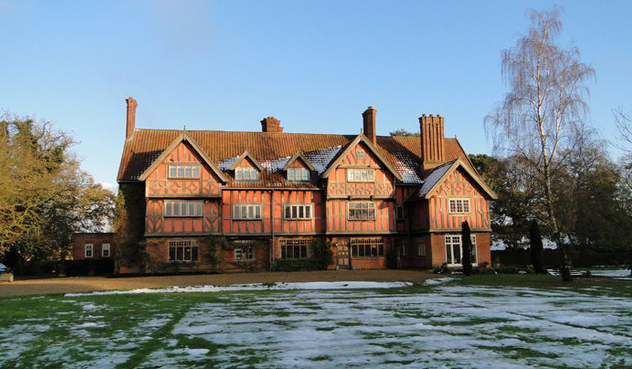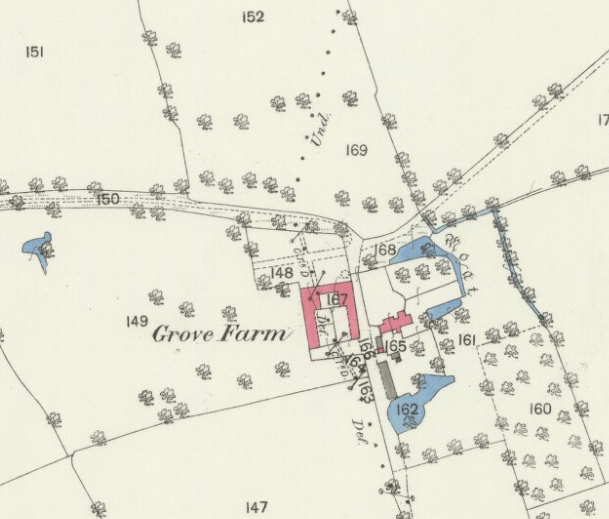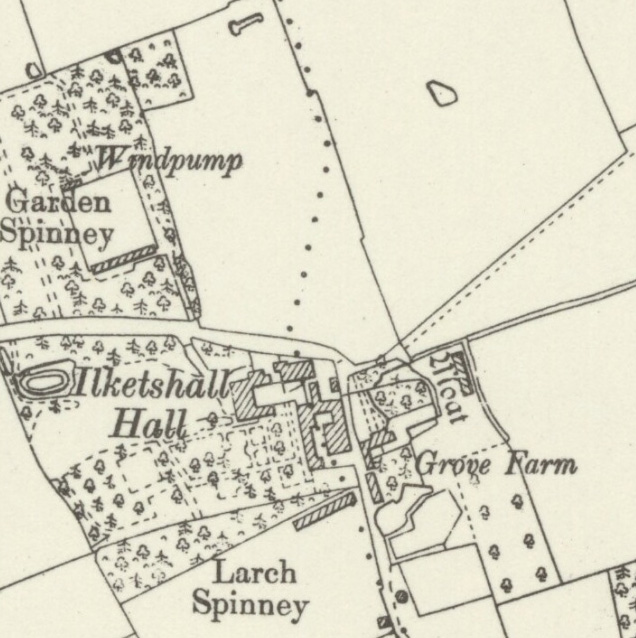Parish: Ilketshall St Lawrence and Ilketshall St Andrew
District Council: EAST SUFFOLK (previously Waveney)
TM 374 856
Not open to the public

Situated c. 8km (5mls) south of Bungay and just off the main Roman road known as Stone Street, Ilketshall Hall dates from c. 1903 and was built in the Arts and Crafts style with mock-Tudor features. It formed part of a farm complex that straddles the parish boundary of Ilketshall St Lawrence and Ilkesthall St Andrew. The site includes a late sixteenth century farmhouse known as Grove Farm (Grade II), which is adjacent to the remains of a post-medieval moat in the parish of Ilketshall St Andrew.
Grove Farm was in the ownership of the Revd Richard Aldous Arnold and was put up for sale after his death in 1879 when it was described as a ‘desirable and compact farm totalling 231 acres [94ha]’. It appears to have been bought by the Adair family of Flixton Hall, c. 9.5km (6mls) to the north-west, who were large landowners in the area. At the beginning of the twentieth century the Adairs built a new house named Ilkeshall Hall to the north-west of the farm buildings that is believed to have been used as a hunting lodge for the Flixton Estate. That use was short-lived and in 1908 the Hall, farm buildings and land were for sale. Walter James Alcock, a paper manufacturer of Hackney Wick, Middlesex, bought the Ilkeshall Hall Estate, at the time Grove Farm was tenanted by David English. Walter is known to have enjoyed shooting on the Flixton Hall Estate, no doubt using Ilkeshall Hall as his home whilst in Suffolk. Walter’s widow continued to live at the Hall after his death in 1932.
The 1928 OS map shows new formal pleasure gardens and paths laid out around the Hall. To the north-west a newly-planted mixed woodland called ‘Garden Spinney’ surrounded a square walled garden with a range of buildings on its south side


Today the Hall is at the centre of a large mixed farming enterprise. The gardens around the Hall survive in a simplified form and the woodland to the north-east has matured. However, the walled garden has been replaced on the same footprint by large poultry sheds using remnants of its brick walls and buttresses in their lower construction.
SOURCES:
Birch, Mel, Suffolk’s Ancient Sites Historic Places, 2004.
Kelly’s Directory of Suffolk, 1916, 1922, 1929, 1937.
Ticehurst, Claud, Buchanan, A History of the Birds of Suffolk, 1932.
White, William, Directory of Suffolk, 1844, 1855.
Details from Walter Alcock’s will as posted in The Argus (Melbourne, Victoria, Australia) 10 August 1932. From the National Library of Australia https://trove.nla.gov.au/newspaper/article/4467463/516365 (accessed October 2019).
Suffolk Gardens Trust Walled Gardens Recording Group visit 2008.
Conversation with the owner of Grove Farm in 2008, Suffolk Gardens Trust Walled Gardens Recording Group visit.
Census: 1881, 1901, 1911.
1884 (surveyed 1883) Ordnance Survey map.
1928 (surveyed 1926) OS map.
1951 (surveyed 1947) OS map.
2022 Google aerial map (Imagery © Bluesky, CNES / Airbus, Getmapping plc, Infoterra Lts & Bluesky, Maxar Technologies, Map data © 2022).
Heritage Assets:
Suffolk Historic Environment Record (SHER): ISA 002.
Homestead moat at Grove Farm Cottages, Historic England Research Records Hob Uid: 391632.
Grove Farmhouse (Grade II), Historic England No: 1032015.
Suffolk Record Office (now Suffolk Archives):
SRO (Lowestoft) 1039/12/8. Particulars and conditions of a sale of a farm at St. Andrew’s & St. Lawrence, Ilketshall, 1879.
SRO (Lowestoft) 1039/12/8. Sales particulars of Ilketshall Hall Estate, 1908.
SRO (Lowestoft) 741/HA12/D8/8/13. Photograph in the Adair family archive showing W. J. Alcock and others shooting on the Flixton Hall Estate.
Norfolk Record Office BR 184/2834. Sales particulars of Ilketshall Hall Estate, 1958.
Site ownership: Private
Study written: January 2023
Type of Study: Desktop
Written by: Tina Ranft
Amended:
